ISSN ONLINE(2319-8753)PRINT(2347-6710)
ISSN ONLINE(2319-8753)PRINT(2347-6710)
Akshatha D.S1, Manavendra.G2, S.Kumarappa3
|
| Related article at Pubmed, Scholar Google |
Visit for more related articles at International Journal of Innovative Research in Science, Engineering and Technology
In recent years much research has been carried to find suitable alternative fuel to petroleum products. In the present investigation experimental work has been carried out to analyze the performance and emissions characteristics of a single cylinder compression ignition DI engine fuelled with the blends of mineral diesel and biodiesel at the different injection pressures. The optimal value of the injection pressure was observed as 250 bars in the range of 210 to 290 bar. The performance parameters evaluated were brake thermal efficiency, break specific fuel consumption and the emissions measured were carbon monoxide (CO), carbon dioxide (CO2), hydrocarbon (HC).This study is based on the reports of researcher who published their findings. It was reported that adding oxygenated additives improved flash point, density and viscosity of the biodiesel fuel, depending on the composition of additives. Engine performance values did not change significantly with biodiesel fuels, but exhaust emission profile was improved. the additive showed an improvement in the efficiency of the engine. Anti oxygen additives quite effective in controlling NOx formation and HC emission.
Keywords |
| Neem Biodiesel, performance, emission, CI Engine, Additives. |
INTRODUCTION |
| Oil provides energy for 95% of transportation and the demand of transport fuel continues to rise. The requirement of Motor Spirit is expected to grow from little over 7MMT in 2001 –02 to over 10 MMT in 2006-07 and 12.848 MMT in 2011-12 and that of diesel (HSD) from 39.815 MMT in 2001-02 to 52.324 MMT in 2006-07 and just over 66MMT in 2011-12. The domestic supply of crude will satisfy only about 22% of the demand and the rest will have to be met from imported crude. Our dependence on import of oil will continue to increase in the foreseeable future. It has been estimated that the demand for crude oil would go up to 85 MMTPA from about 50 MMTPA in 2001-02while the domestic production will be around 22% of the demand. The crude prices and availability are subject to great volatility depending upon the international situation and, therefore, attempt needs to be made to reduce dependence on imports. In bio fuels the country has a ray of hope. Bio fuels are renewable liquid fuels coming from biological raw material and have been proved to be good substitutes for oil in the transportation sector. As such bio fuels – ethanol and biodiesel- are gaining worldwide acceptance as a solution to environmental problems, energy security, reducing imports, rural employment and improving agricultural economy. Ethanol is used as fuel or as an oxygenate to gasoline. Raw material used for producing ethanol varies from sugar, cereals, sugar beet to molasses in India. Brazil uses ethanol as 100 % fuel in about 20 per cent of vehicles and 25% blend with gasoline in the rest of the vehicles. USA uses 10 % ethanol-gasoline blends whereas a 5% blend is used in Sweden. Australia uses 10% ethanol- gasoline blend. Use of 5% ethanol- gasoline blend is already approved by BIS and is in progressive state of implementation in the country.BIS standards for 10% blend need to be drafted after conducting trials and fixing parameters. Biodiesel is made from virgin or used vegetable oils (both edible & non-edible and animal fats through transesterification and is a diesel substitute and requires very little or no engine modifications up to 20% blend and minor modification for higher percentage blends. The use of biodiesel results in substantial reduction of un-burnt hydrocarbons, carbon monoxide and particulate matters. It has almost no sulphur, no aromatics and has about 10 % built in oxygen, which helps it to burn fully. Its higher cetane number improves the combustion. |
| Sunflower and rapeseed are the raw materials used in Europe whereas soybean is used in USA. Thailand uses palm oil, Ireland uses frying oil and animal fats. It is proposed to use non-edible oil for making biodiesel. The trans-esterification process in an industrial unit can be summarized as following: the oil, after acid correction is transferred to the first reactor. In a second reactor, the catalyst (KOH or NaOH) and the alcohol (NaOH or KOH) are organized and transferred to the first reactor. The reaction is completed in 50 min, at a temperature between 50 and 600C. The biodiesel (upper layer) is then separated from the raw glycerin (lower layer) by decantation (on batch process) or by centrifugation (on continuous process). The lower layer, besides raw glycerin, contains part of the alcohol that could be recovered and reused in the processes. [1] Biodiesel production from CJCO with a high content of FFA has been investigated. In alkali base catalyzed trans-esterification process, the presence of high concentration of FFA reduced the yield of methyl esters of fatty acids significantly. A two-stage trans-esterification process was selected to improve the methyl ester yield. The first stage was acid pre-treatment process, which could reduce the FFA level of CJCO to less than 1%. The second stage, alkali base catalyzed trans-esterification process gave 90% methyl ester. [2]. Biodiesel fuel is gaining more interest as an attractive alternative fuel due to the environmental pollution and diminishing supply of fossil fuel. Biodiesel has similar combustion characteristics as diesel and biodiesel blend can reduce hydrocarbons, smoke opacity, particulate matters, carbon dioxide and but NOx emissions have slightly increased. However exhaust emissions of NOx can be controlled by adopting certain strategies such as changing the composition of feedstock, improve the cetane number, retardation of injection timing and exhaust gas recirculation. On the other hand, the main drawbacks of vegetable oil have to overcome due to the high viscosity, low volatility which will cause poor combustion in diesel engines. [3] |
OBJECTIVES OF THE PRESENT STUDY |
| The main objective of this investigation was to study the use of neem (Azadirachtaindica) methyl esters in CI engine experimentally. Preparation of methyl esters were from non-edible oil using transestrification process. The use of neem oil biodiesel (neem oil methyl ester, NOME) blended with mineral diesel as substitute for conventional mineral diesel . The purpose of the investigation is to analyze the effects on diesel engine performance when fueled with the blends of biodiesel and diesel in various proportions on volume basis. The fuel blends investigated for performance analysis are 100% diesel (B00), blend of 20% biodiesel and 80% diesel (B20), blend of 40% biodiesel and 60% diesel (B40) and further 10%, 15% Di ethyl ether is added to the blends and results are to be compared. The experimentation further extended to procure most desirable values for the relevant working parameters and their optimal combination based on the results. The performance parameters like, |
| 1. Brake specific fuel consumption. |
| 2. Brake thermal efficiency. |
| 3. Mechanical efficiency. |
| 4. Exhaust gas temperature. |
| 5. Emission of CO, CO2, HC. |
| 6. Combustion analysis. |
| To study the effect of injection pressure on the performance of a diesel engine using blends of biodiesel and diesel as fuel. The injection pressure was varied in the range 210, 250 and 290 bar recommended for diesel fuel operation. Tests were carried out on single cylinder, four stroke and direct injection diesel engine. |
| A. Neem as Biodiesel: Biodiesel is a clean burning alternative fuel, produced from domestically grown, renewable resources. Biodiesel contains no petroleum products, but can be blended at any concentration with diesel from fossil sources to create a biodiesel blend. It can be used in compression ignition engines with little or no modification. Biodiesel is simple to use, biodegradable, nontoxic, and basically free of sulfur compounds and aromatics. B. Pure Neem Oil Extraction Method: Quality of neem oil depends on the type of extraction. Manufacturing of neem oil includes the collection of raw materials for the extraction and selection of extraction method. Neem oil is extracted from neem leaf and need seed. Neem seed is widely used in the extraction process instead of neem leaf as the oil content is found to be more in seeds than in the leaf. Neem oil extraction is done by Mechanical pressing, Steam pressure extraction and Solvent extraction. Primary process of extraction consists of grade wise separation of seeds. Grading of seeds is done according to the amount of oil content in the seeds and with sizes as well. |
| Firstly, the fruits are collected in a drum, and the kernels are separated to obtain the seeds. Later the seeds are woven dried and then feed into the oil extracting machine in case of mechanical pressing method. The neem oil is obtained by pressing it mechanically and collected in a drum. Thus filtration is done to remove the various unwanted particles left in the extracted oil in order to obtain pure neem oil. Flow chart for the extraction process is as shown in figure below. |
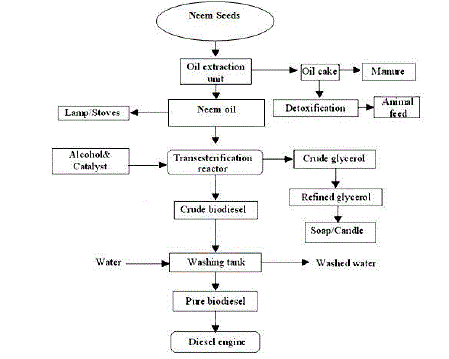 |
| In case of Steam pressure extraction method, the neem seeds after the drying process are feed into the steam boiler. This process makes the extraction process easier. The seeds get swollen by steaming thus the oil in squeezing becomes easy. The process of steaming is accompanied by increasing of pressure in the boiler which drives the oil out from the seed without any pressing. In some industries, the left seed's kernels after the steam boiling is pressed to further extraction of oil up to 98% leaving just the outer layer of the seeds. The same filtering process is followed as done in the mechanical pressing method. |
| In solvent extraction method, solvents like petrol or white gasoline is mixed with the seeds after woven drying. The solvents help in extracting the neem oil out of the kernel up to certain percent. Added to that the neem seeds are pressed if needed. The resulting oil is stored in a silo where the pure neem oil is recovered from the crude one. In the latest method of cold pressing, it is seen that the purest form of neem oil is obtained along with the presence of active compounds. The oil extracted using cold press method seems to be lighter in color as well as odor when compared with other methods. C. Transesterification of Neem Biodiesel: The esterified oil (below 4% FFA) was poured into the reactor and heated at 60°C to optimize the temperature of reaction for maximum yield. A mixture of NaOH in methanol was heated at the same temperature for 5 min and added slowly to the heated oil. The reaction mixture was heated, refluxed and stirred at 400 rpm for about 3 hours. After 3 hours, two distinct layers were formed and the mixture was allowed to settle for 2 hours or overnight. The heavier glycerol layer was separated from the lighter Methyl ester layer in separating tank. Then they obtained Methyl ester is poured into the Recovery tank for the methanol recovery where it is heated up to the temperature 70°C, the methanol will be vaporized and condensed at condenser. Next they obtained Biodiesel is transferred into the washing tank where it is washed by spraying the warm water to remove the NaOH content. Finally we get pure biodiesel. |
| The quantity of biodiesel produced and the byproducts of biodiesel production in one liter production unit is listed below. The table contains quantity of raw material required and the quantity of final oroducts obtained. |
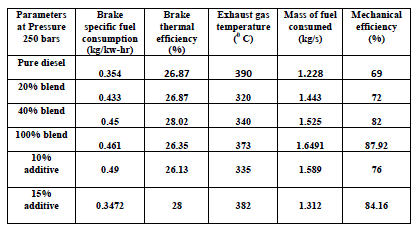 |
| D. Blending of diesel and Neem biodiesel: Blending conventional Diesel Fuel (DF) with Neem biodiesel is presently the most common form of bio-diesel. The most common ratio is 80% conventional diesel fuel and 20% Neem oil ester, also termed “B20,” indicating the 20% level of bio-diesel; There have been numerous reports that significant emission reductions are achieved with these blends. Several studies have shown that diesel/bio-diesel blends reduce smoke opacity, particulates, un-burnt hydrocarbons, carbon dioxide and carbon monoxide emissions, but nitrous monoxide emissions are slightly increased. One limitation to the use of bio-diesel is its tendency to crystallize at low temperatures below 0°C. Methyl and ethyl esters of edible oils will crystallize and separate from diesel at temperatures often experienced in winter time operation. |
| In our engine study blending ratios are 20%, 40%and 100% of biodiesel to diesel ratio; further diethyl ether additive is added to the biodiesel blend in 10% and 15% respectively and analysis is carried out. E. Diethyl ether as additive: Diethyl ether, also known as ethyl ether, sulfuric ether, simply ether, or ethoxyethane, is an organic compound in the ether class with the formula (C2H5O2). It is a colorless, highly volatile flammable liquid. It is commonly used as a solvent. Diethyl ether has a high cetane number of 85-96 and is used as a starting fluid, in combination with petroleum distillates for gasoline and diesel engines because of its high volatility and low flash point. For the same reason it is also used as a component of the fuel mixture for carbureted compression ignition model engines |
RESULTS AND DISCUSSIONS |
| Performance Analysis, at injection pressure 210 bars, 1500rpm |
| 1. Brake specific fuel consumption (BSFC) |
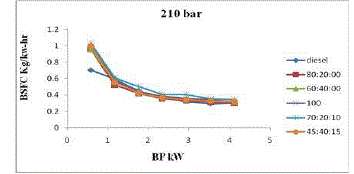 |
| Graph1.shows the Variation of brake specific fuel consumption with brake power for Neem methyl ester and its respective additive blends-210 bar |
| The variation in brake specific fuel consumption with load for different fuels shows decline with increase in load. One possible explanation for this could be due to more increase in brake power with load as compared with fuel consumption. The BSFC in case of blends were higher compared to diesel in the entire load range, due to its lower heating value, greater density and hence higher bulk modulus. The higher bulk modulus results in more discharge of fuel for same displacement of the plunger in injection pump, there by resulting increase in BSFC. BSFC for 10% additive blend is more compared to that of Neem oil blends, as the heating values are higher for additive blends compared to Neem blends, with further increase in the concentration of additive it is clearly observed that the values of BSFC tends to decrease. Graph 1.shows the decrease of brake specific fuel consumption with increasing load. |
| 2.Brake thermal efficiency (BTE) |
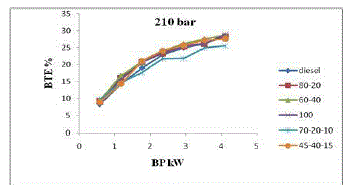 |
| Graph2.shows the Variation of brake thermal efficiency with brake power for Neem methyl ester and its respective additive blends-210 bar |
| The BTE of different fuels is shown as a function of load. The variation in brake thermal efficiency for various blends was less than at part load than at higher load due to the raised temperatures inside the cylinder. The brake thermal efficiencies of diesel and the blends of biodiesel with diesel were seen increased with increase in load but tended to Decrease with further increase in load. The BTE of Neem blends were lower than with diesel throughout the entire range showing the poor combustion characteristics of methyl ester due to high viscosity and poor volatility. The BTE of B20 NOME is closer to that of diesel. The BTE of B40 NOME is found to be better. BTE of 10% additive mixtures have the efficiency less than 1.8% compared to B100, While the efficiency of 15% additive blends are higher by 2% because of improved combustion of oxygenated additive.Graph.2. shows the increase in brake thermal efficiency of Neem blends compared to diesel with increasing load. |
| 3. Exhaust gas temperature (EGT) |
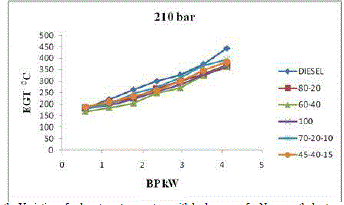 |
| Graph 3.shows the Variation of exhaust gas temperature with brake power for Neem methyl ester and its respective additive blends-210 bar |
| It is evident from the graph that exhaust gas temperature is increased along with the increase in load for all fuels. The mean temperature increased linearly for 150C at no load to 350C at full load with average increase of 30% with 25% increase in load. The increase in exhaust gas temperature with load is obvious from the fact that more fuel is required to take additional load. The exhaust gas temperature was found to increase with increasing concentration of Neem biodiesel in the blends, but the exhaust gas temperature of diesel was high compared to biodiesel blends. This could be due to lower heat transfer rate in case of biodiesel which in evident from trends of thermal efficiency. EGT of additive blends also tends to increase with increasing load, exhaust temperature of additive blends are higher than the blends of NOME and lower than that of diesel fuels. Graph 3.shows the increasing rate of exhaust gas temperature with constant increasing load. |
| 4. Mass of fuel consumed (mf) |
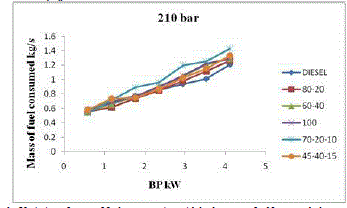 |
| Graph.4.shows the Variation of mass of fuel consumption with brake power for Neem methyl ester and its respective additive blends-210 bar |
| The variation in mass of fuel consumption with load for different fuels blends increases with increase in load, due to lower calorific value of biodiesel in comparison with mineral diesel. This happened due to extra amount of oxygen present on the blend which is taking part in combustion process. Mass of fuel consumed by additive blends also tends to increase with increasing load as the oxygenated additives burn more clearly and completely compared to diesel and NOME blends. |
| Graph.4 indicates that the mass of fuel consumed goes on increasing with increasing loads and at optimum load it tends to decrease, due to insufficient amount of oxygen required for complete combustion. |
| 5. Mechanical efficiency (ηm) |
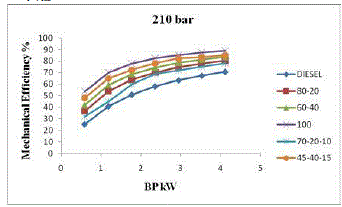 |
| Graph 5.shows the Variation of mechanical efficiency with brake power for Neem methyl ester and its respective additive blends-210 bar |
| From the graph.5 it is the evident that mechanical efficiency increases with increasing load respectively. Mechanical efficiency of Neem biodiesel blends are higher than that of the mineral diesel, as the percentage of blends increases the efficiency also tends to increase drastically this is due to the complete combustion of fuel and brake thermal parameters. |
| 6. Variation of performance parameters at different injection pressure is tabulated and listed in the table below: |
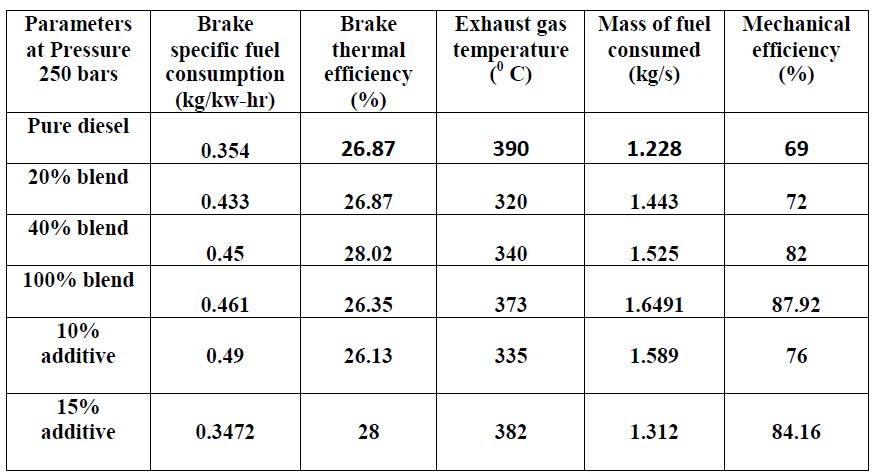 |
| Performance of engine is optimum at injection pressure of 250 bars and falls with further increase in injection pressure. At low injection pressures of 210 bar the BTE is lowest possibly due to the coarser size of fuel particles and lower depth of penetration in the combustion chamber resulting in longer time for combustion. When the injection pressure is increased to 250 bar the better mixing and proper utilization of air converted more heat into the useful work resulting in higher BTE of around 3.5%. When injection pressure is further increased to 290 bars, the performance tends to decreased as against the normal trend. The probable cause can be attributed to the large pressure difference between the cylinder and the injection producing too high turbulence with fuel spray striking the colds walls of combustion chamber absenting the combustion process, lowering the efficiency. |
CONCLUSION |
| Biodiesel is a viable substitute for petroleum-based diesel fuel. Its advantages are improved lubricity, higher cetane number, cleaner emissions, reduced global warming. Neem as biodiesel has potential as an alternative energy source. However, this oil alone will not solve our dependence on foreign oil within any practical time frame. Use of this with other alternative energy sources and suitable additives could contribute to a more stable supply of energy. Biodiesel thus produced meets the standard biodiesel specifications. The production and consumption of biodiesel will inevitably rise in future due to low environmental impact, ease of handling, and possibility of use without need for major adjustments of existing engines of motor vehicles. |
| Production and use of biodiesel leads to |
| Saves foreign exchange. |
| Improves energy security of the nation. |
| Provides employment to rural masses. |
| Produce sustainable and relatively inexpensive fuel. |
| Start propagating the concept with village population to supplement their income with the existing tree population. |
| Based on engine performance tests, it can be concluded that biodiesel blends can be used satisfactorily in the diesel engine without any major modifications in the hardware of the system. |
| The fuel consumption of the engine was somewhat higher at low loads and speeds on fuel blends due to lower gross heat of combustion and mass of fuel consumed increases with increasing injection pressure. |
| The BTE of Neem blends were lower than with diesel throughout the entire range showing the poor combustion characteristics of methyl ester due to high viscosity and poor volatility. When the injection pressure is increased to 250 bar the better mixing and proper utilization of air converted more heat into the useful work resulting in higher BTE of around 3.5%, with further increase in pressure to 290 bars, BTE tends to decrease. The emissions of hydrocarbons (HC), carbon monoxide (CO) are considerably reduced for all biodiesel and additive blends, as injection pressure is increased the emissions goes on decreasing due to complete combustion of fuels. Knocking is not observed for biodiesel blend at all operating conditions. Irrespective of all difficulties mentioned in the study, biodiesel and diesel fuel blends may prove an alternative option as diesel fuel in the future because they are renewable resources and less polluting. |
References |
|